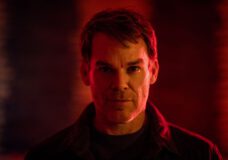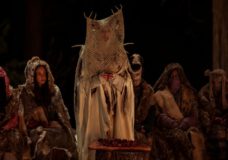There is a LOT to unpack in the latest episode of Fargo, some of which will likely be easier when we see what happens next. “East/West” may *look* like a detour into surrealist Midcentury Italian cinema when it opens, but the minute the wind starts blowing through black and white Kansas … you know where you are.
RELATED: Missed the last episode? Catch up here!
“East/West” is a cunningly timed bottle episode. After last week’s sincere entry into all-out war, as well as the deaths of several key players, one might have hoped to watch the action in Kansas City escalate. Instead, we downshift hard into the side story of Satchel (Rodney L Jones III) and Rabbi (Ben Whishaw) on the lam, with Constant Calamita (Gaetano Bruno) on their tail.
From the first grayscale frame, it’s clear that were aren’t in Kansas City anymore. We are, in fact, in Kansas.
The episode opens with Omie Sparkman (Corey Hendrix) pulling into a filling station on a desolate road in Kansas. He has a white man in his trunk, an informant who has helped him track Calamita to the Liberal, Kansas, area. The filling station attendant tells Omie that this is the only place for gas for miles, and that if Calamita hasn’t been through yet, he definitely will. They broker an arrangement wherein Omie and his captive paint the building in exchange for being allowed to lie in wait.
As they break for a Coke, Calamita arrives. The captive makes a run for it, and Omie shoots him dead and drags his body out of sight.
Rewind one day, to Rabbi and Satchel driving past the same station. The reason they’re heading toward Liberal is that Rabbi spent enough time there at some point to have stashed $5000 in a feed store in case he needed it. He takes Satchel to a quirky (to say the least) boardinghouse, owned by feuding, deaf, elderly sisters. Their room is assigned based on Rabbi’s political and New Testament leanings, which place them in the west wing.
The house sits alone in a barren landscape composed of post-harvest fields coated halfheartedly with snow. Outside the door is a plaque that reads:
KANSAS
HISTORICAL MARKER
THE MELLON MOUNDS
On this spot stood the Mellon Mounds, named for the infamous Mellon family, who lured unsuspecting travelers into their home, fed them and then dispatched them with a hammer. They buried their victims in a neighboring orchard, unbeknownst to the townspeople.
As more and more travelers vanished, suspicion began to circle the Mellons. Shortly thereafter, the family disappeared. In the spring of 1894, the victims’ bodies were discovered, sending the town into hysteria. The Mellons are believed to have killed over a dozen people, including a child.
Although stories abound, the ultimate fate of the murderous Mellon family was never discovered. Some believe justice came to them in the end. but many still live in fear of their bloody hammer.
(In case you wondered after reading that, like I did, what year “The Mulligan Concern” arrived in Kansas City, it was 1920. Rabbi would not have been one of the Mellons.)
The desk clerk who shows them to their room warns them that the sisters don’t care for “colored people,” a refrain echoed repeatedly through this episode. Everywhere Satchel and Rabbi appear together, someone calls out the color of Satchel’s skin and questions their connection. Rabbi has a tailor-made response for each situation, but the active reminder of reality for black Americans in 1950 definitely adds to the tension of the episode.
As they make their way up to the top floor, they peer in the open rooms of the other tenants. Next to their room is a “hospital man,” an obese white man with bandages all over him and some kind of skin condition that makes him look monstrous to the passing child. He’s connected to a medical machine and has a hovering attendant with goggles on, ministering to him with a hypodermic needle.
Across the hall from them, on the “east” side of the building, is an Old Testament preacher and his mother (whom the resident gabby salesman- west- mistakes for the preacher’s wife). Also in residence on the east is a “hero of Wounded Knee” (as if there was such a thing) and his “niece,” a minor girl who’s relationship to the old man is likely not familial. Rounding out the boardinghouse crew (west side) is a young man on his way to make it rich on the Texas oil fields.
Shortly after they’ve settled, Rabbi leaves Satchel alone with his usual goodbye of, “If I don’t come back, I’m dead or in jail.” He drives into Liberal to see about the money he left behind, only to discover that the feed store was sold at auction and has been converted to an appliance store by a pair of brothers. The wall wherein he hid his cash is gone, and he knows with certainty that the brothers found it.
In Rabbi’s absence, Satchel discovers a Jack Russel terrier hiding in the wardrobe in his room. Her tag says her name is Rabbit. Satchel decides to keep her, without asking anyone in the building whose she is, and Rabbi’s only objection to this when he meets her is that she makes noise.
Whenever he is asked a question about himself, Satchel’s response is that he is hungry. He finally gets to eat that evening at a bizarre dinner of fish sticks and potatoes. All of the bizarre characters in the house sit around the table, except the hospital man and his companion, and the table (like the whole house) is split into two meals, two styles of décor and two serving staffs in accordance with the sisters’ feud.
The next day, Rabbi goes back to the appliance store and recovers his remaining cash from the brothers at gunpoint. He leaves Satchel in the car with Rabbit while he’s doing this, and the boy is approached by a nervous policeman who prepares to draw his weapon as he asks Satchel to leave the car. Fortunately, Rabbi returns in time to shut down the likely police shooting and receives a warning from the officer about keeping his colored boy out of sight in a town like that.
They return to their room, where Rabbi informs Satchel that they’ll be leaving that night as he counts his money. Satchel asks to keep Rabbit, and Rabbi refuses … until he learns that it’s the boy’s birthday. This tugs his heartstrings, inspiring him to leave the boardinghouse in search of some kind of birthday treat for his ward.
Rabbi makes his way to the filling station in search of a cupcake or candy bar. He does not deliver his usual parting words to Satchel.
When he pulls into the drive, he spots Calamita’s empty car at the pump immediately. He steps out of his car, gun drawn, and discovers the filling station attendant’s body in a doorway. He then cautiously looks through a window, where he sees Calamita standing over a wounded Omie, gun drawn. Calamita notices him and shoots twice out the window. Rabbi retreats to take cover behind his vehicle, and Calamita catches him with a bullet in the arm before he’s in the clear, making it difficult to return fire.
As Calamita advances on him, Rabbi tries to grip his gun well enough to shoot. Fortunately, Omie appears behind Calamita and gets him with his last bullet. It isn’t a kill shot, though, and Calamita whips around to put Omie down. He returns his attention to Rabbi, who has noticed something behind the Italian: a bona fide Wizard of Oz tornado.
Calamita is swept up into the funnel, along with the filling station and the bodies littering its floors. It first seems like Rabbi might escape, but ultimately he raises his hands in surrender and flies up into the clouds.
Later, Satchel awakens to find that he’s fallen asleep and doesn’t know where his friend has gone. And everything is in color!
Satchel tries looking for Rabbi, but a short conversation with the hospital man and a glimpse of the preacher and his mother folding a flag in their underwear (night wear?) are enough to drive him back into his own room, where he bars the door with a chair and falls asleep again with gun in his hand.
When he wakes alone again in the morning, Satchel takes Rabbit for a walk down the lane to where a man has finished building a cryptic billboard featuring a white man in a suit and hat smiling expectantly in front of a ranch style house. It declares, “THE FUTURE IS NOW.”
Satchel walks down the road with his dog.
If this really is Oz, then Satchel is Dorothy and Rabbit is Toto. In The Wizard of Oz, things are in black and white in Kansas and turn color after the Cyclone drops Dorothy and Toto in Oz. Does that mean that Satchel has just landed in Oz now? Will this theme continue next week? Is Rabbi really dead? Guess we’ll have to wait to find out …
RELATED: Keep up with our Fargo Season Four recaps here!
- WANDAVISION Finale Recap: (S01E09) The Series Finale - March 5, 2021
- WANDAVISION Recap: (S01E08) Previously On - February 28, 2021
- WANDAVISION Recap: (S01E07) Breaking the Fourth Wall - February 19, 2021







